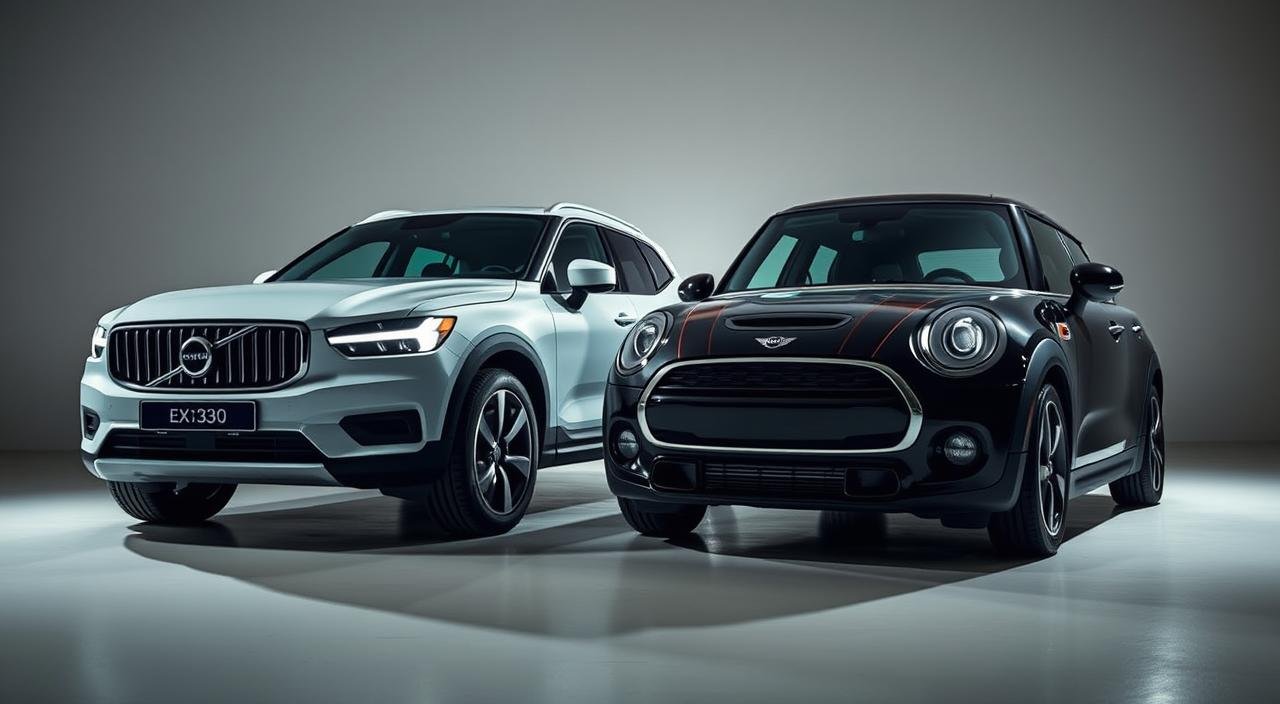
Aug
Can two electric vehicles from opposite design philosophies satisfy the same premium buyer in India’s evolving EV market?
The Indian electric vehicle landscape welcomes two distinct competitors in the premium entry-level segment. Volvo prepares to launch the EX30 as its most accessible electric crossover in the coming weeks. Mini counters with an updated Cooper SE that maintains its iconic hot hatch character while embracing electric power.
This EV comparison reveals contrasting approaches to premium electric mobility. The Volvo EX30 targets practical buyers seeking crossover versatility at an expected Rs 50 lakh starting price. The Mini Cooper SE appeals to driving enthusiasts willing to pay Rs 55 lakh for sporty electric performance in a compact package.
Both premium entry EVs represent strategic moves by established brands to capture India’s growing electric vehicle market. Volvo extends its sustainability commitment with the EX30’s modern design language and crossover positioning. Mini transforms its beloved Cooper into an electric performer without sacrificing its go-kart driving dynamics.
The price difference of Rs 5 lakh between these models reflects their distinct market positions. Buyers must choose between the EX30’s practical space and the Cooper SE’s performance-focused approach. Each vehicle offers unique advantages that define what premium entry EVs can deliver in today’s market.
Key Takeaways
- Volvo EX30 starts at Rs 50 lakh while Mini Cooper SE begins at Rs 55 lakh
- EX30 offers crossover practicality versus Cooper SE’s hot hatch performance
- Both models target premium buyers entering the electric vehicle segment
- Volvo launches in coming weeks with modern design and sustainability focus
- Mini maintains iconic styling while adding electric powertrain technology
- Price gap reflects different approaches to premium electric mobility
- Choice depends on buyer preference for space versus driving dynamics
Overview of Premium Entry EVs
The car world is changing fast. Now, we see more affordable electric cars that are fancy but not too pricey. These cars offer cool tech and luxury without the high cost of top models. They make electric cars more available to more people, keeping quality high.
What Are Premium Entry EVs?
Premium entry electric cars sit between regular and luxury cars. They have fancy features like leather seats and smart tech for about $30,000 to $45,000. They focus on design and driving fun, but are priced for more people.
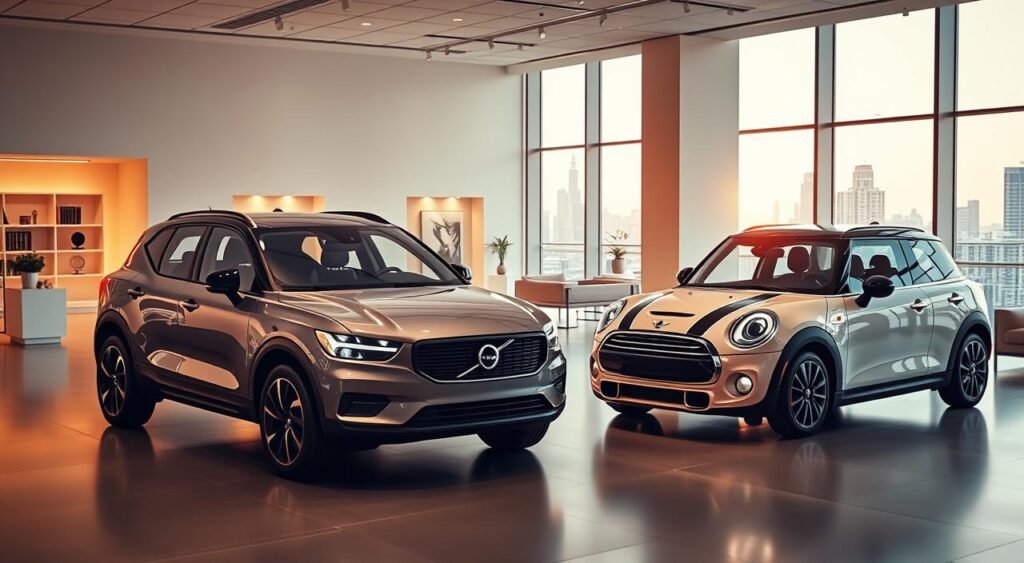
Popularity and Market Trends
Sales of these cars are skyrocketing. Makers are pricing them well and giving great lease deals. This makes electric cars more attractive to many buyers. In India, more charging spots and government help are boosting electric car sales, with these models leading the way.
Key Features of Modern Electric Vehicles
Today’s affordable electric cars have features usually found in luxury cars:
- Range capabilities between 200-300 miles per charge
- Fast-charging support reaching 80% in under 30 minutes
- Connected services with smartphone integration
- Sustainable interior materials including recycled plastics
- Advanced safety systems earning top crash test ratings
These cars are also good for the wallet, with efficiency ratings of 3.4-4.0 miles per kWh. They’re great for daily drives and weekend trips.
Design and Aesthetics
The look of electric cars is key in drawing in customers. The Volvo EX30 and Mini Cooper SE show off different styles. These styles reflect their brand’s history and modern electric car trends. They bring new looks to the electric car market.
Exterior Design Comparisons
The Volvo EX30 is longer than the Mini Cooper SE. It’s 14.8 inches longer, giving it a stronger look on the road. The EX30 is also wider and taller, making it look more solid compared to the Mini.
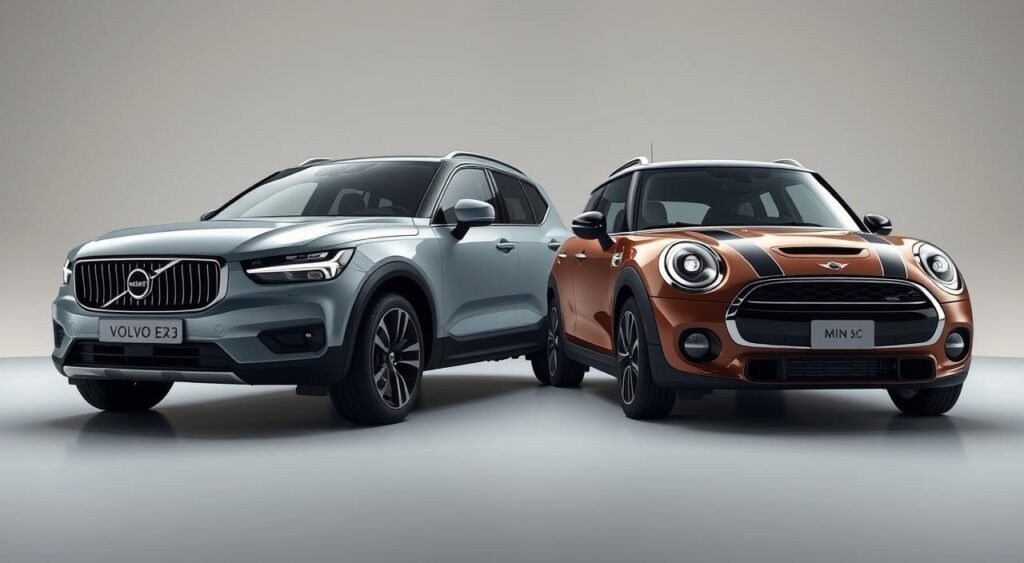
The EX30 has a longer wheelbase than the Mini. This means more room inside and a smoother ride. The Volvo has 19-inch wheels, while the Mini has 17-inch wheels. This affects how they look and handle.
Interior Comfort and Materials
Inside, both cars have a simple design. They don’t have traditional gauges. Instead, they use digital screens for a clean look. The EX30 has more room for your head and legs.
The Volvo has a fixed panoramic roof, adding natural light. This makes the car feel bigger and more comfortable on long trips. Both cars use eco-friendly materials in their interiors, pleasing those who care about the planet.
Color Options and Customization
Customizing your car is important for many buyers. Each brand has its own color choices:
| Feature | Volvo EX30 | Mini Cooper SE |
|---|---|---|
| Exterior Colors | 5 options including Cloud Blue | 8 options including British Racing Green |
| Interior Themes | 4 sustainable material combinations | 3 traditional and vegan options |
| Wheel Designs | 2 styles in 19-inch | 3 styles in 17-18 inch |
| Roof Options | Fixed panoramic glass | Standard or contrast color |
Mini Cooper and Volvo take different paths in customization. Mini offers more colors, keeping its fun vibe. Volvo goes for elegant, eco-friendly options, appealing to those who value refined simplicity.
Performance and Driving Experience
Performance is key when choosing a premium electric car. The Volvo EX30 and Mini Cooper SE offer different electric driving experiences. They cater to various tastes and needs in India.
Acceleration and Speed
The Volvo EX30 is fast, thanks to its rear-wheel-drive setup. It has a 272PS electric motor and 343Nm of torque. It goes from 0-100 kmph in just 5.3 seconds, making it one of the fastest in its class.
The Mini Cooper SE has a 184PS electric motor. While exact acceleration figures for India aren’t confirmed, it’s fast and true to Mini’s sporty vibe.
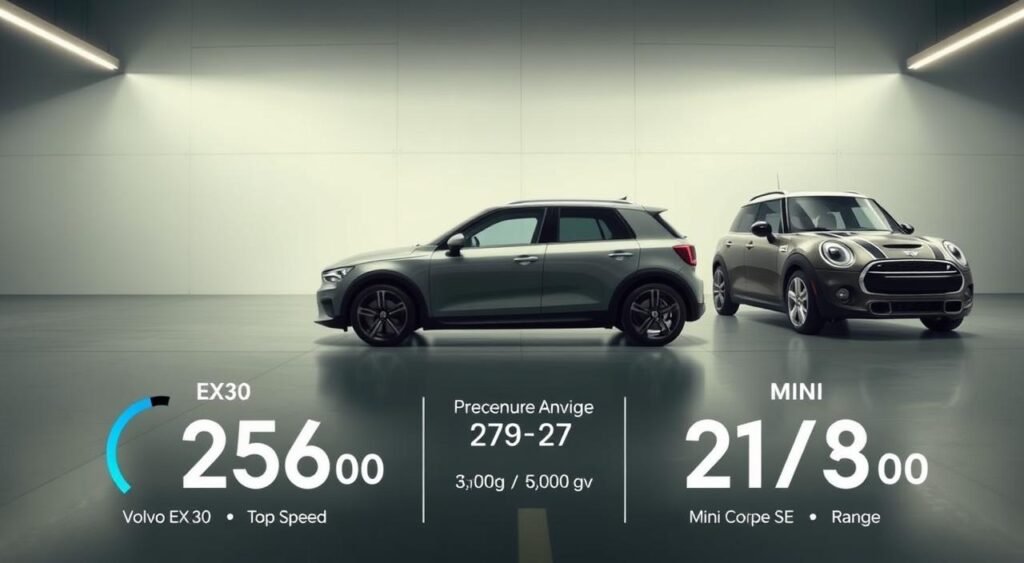
Handling and Ride Quality
Both cars are great in cities, but they handle differently. The EX30 has balanced dynamics, while the Mini Cooper SE has the brand’s signature go-kart feel. Their small size makes them perfect for India’s busy streets.
Battery Range and Charging Times
The Volvo EX30 has a big advantage in range. Its 69kWh battery pack offers up to 480km WLTP-claimed range. The Mini Cooper SE has a 36.6kWh battery, good for about 298km. The EX30’s longer range is better for longer trips in India.
Technology and Infotainment
The digital experience inside premium electric vehicles is key to daily driving. The Volvo EX30 and Mini Cooper SE offer impressive tech features. These features make the cabin a connected hub, keeping drivers and passengers entertained.
Dashboard Layout and Usability
The Volvo vs Mini EVs comparison shows different interior designs. The EX30 has a single 12.3-inch touchscreen for all controls. This design makes the interior look clean and simple.
The Mini Cooper SE also has a modern design. It features a 9.45-inch circular display. This keeps the brand’s iconic look while using the latest tech.
Connectivity Features
Both vehicles are great at keeping drivers connected. They come with:
- Wireless Apple CarPlay and Android Auto
- Wireless phone charging pads
- Connected car technology with smartphone apps
- Multiple USB-C ports for device charging
The EX30’s larger screen is perfect for navigation and media. The Cooper SE has a heads-up display for important info on the windshield. The EX30 has a 9-speaker Harman Kardon system, while the Cooper SE has its own multi-speaker setup.
Safety Technology and Ratings
Safety is a top priority in these electric vehicles. Both models have advanced safety features. They include multiple airbags, 360-degree cameras, and driver assistance systems.
They also have electronic parking brakes and tire pressure monitoring. The EX30 has dual-zone automatic climate control for comfort. The Cooper SE has customizable interior lighting for ambiance.
Cost and Value Analysis
When you buy an entry-level electric car, it’s not just about the price. The Volvo EX30 and Mini Cooper SE show two different ways to enjoy electric driving in India. Each car has its own special features that attract different buyers.
Pricing Breakdown of Both Models
The Volvo EX30 starts at Rs 50 lakh, making it cheaper than the Mini Cooper SE. The Mini Cooper SE costs Rs 55 lakh. This price difference shows the Mini’s value in its brand and design.
| Model | Expected Price (Ex-showroom) | Battery Capacity | Range (WLTP) | Power Output |
|---|---|---|---|---|
| Volvo EX30 | Rs 50 lakh | 69 kWh | 480 km | 272 PS |
| Mini Cooper SE | Rs 55 lakh | 36.6 kWh | 298 km | 184 PS |
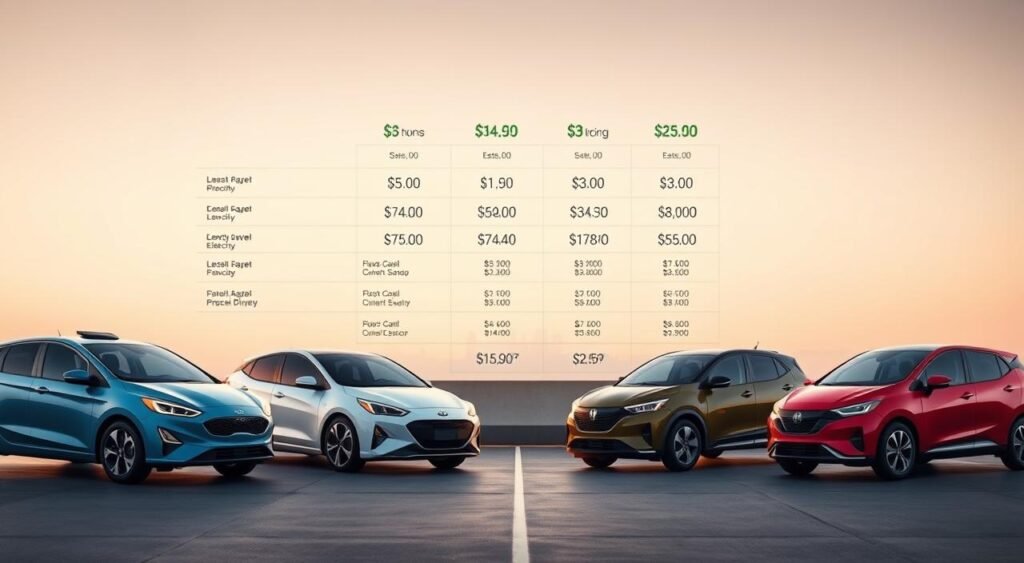
Incentives and Rebates
Indian buyers can get help from state EV incentives. These incentives lower the cost of these electric cars. You can also get tax breaks and lower fees for electric vehicles.
Ownership Costs and Resale Value
The Volvo EX30 has a bigger battery, meaning you charge it less often. It also keeps its range longer than the Mini Cooper SE. Electric cars need less maintenance, saving you money. The EX30 might hold its value better in India’s growing used EV market.
Sustainability and Environmental Impact
When looking at premium electric vehicles, the environment matters a lot. The Volvo EX30 and Mini Cooper SE are big steps toward green travel. They have no tailpipe emissions and cut down on carbon compared to gas cars.
Materials Used in Manufacturing
Electric car makers focus on green materials. Volvo uses recycled plastics and eco-friendly materials in the EX30’s interior. Mini does the same with the Cooper SE, using recycled aluminum and sustainable fabrics for seats.

Energy Consumption Comparison
How efficient electric cars are varies a lot. The Volvo EX30 gets 3.4-3.7 miles per kilowatt-hour. Here’s how it stacks up against others:
| Electric Vehicle Model | Efficiency (m/kWh) |
|---|---|
| Tesla Model 3 | 4.4-5.0 |
| Renault 5 E-Tech | 4.1-4.3 |
| Kia EV3 | 4.0-4.2 |
| Volvo EX30 | 3.4-3.7 |
Long-term Environmental Benefits
Electric cars are better for the planet over time. They cut down on carbon emissions when powered by clean energy. They also improve city air quality by not producing local emissions.
These cars also reduce noise pollution and fossil fuel use. This makes them great for those who care about the environment in India’s growing EV market.
Conclusion and Recommendations
The Volvo EX30 vs Mini Cooper SE shows two different ways to make premium entry EVs. Each car has its own strengths in the electric car world. The EX30 has a big cabin and a large battery. The Cooper SE is small and great for city driving.
Both cars show how electric cars are getting more affordable in India.
Which Model is Right for You?
The Volvo EX30 is perfect for those who need room and range. It’s big, so it’s comfy for families and long trips. Its battery lasts longer, making it easy to drive on highways.
The Mini Cooper SE is ideal for city drivers who want to be quick. It’s small, so it’s easy to park. It looks cool and has a rich brand history.
Final Thoughts on Volvo EX30 and Mini Cooper SE
The Volvo Mini Cooper comparison highlights their different focuses. The EX30 has a big roof and screen for more comfort. The Cooper SE has a display for the driver to stay focused.
The EX30 is cheaper, which is good for those watching their budget. The Cooper SE is for those who love the Mini brand. Prices and details for India will help you decide.
The Future of Entry-Level Premium EVs
Premium entry EVs like these are a sign of good things to come. They’re high-quality and affordable. New tech means better batteries and faster charging.
As India’s electric car market grows, we’ll see more choices. This competition makes both brands offer better deals. You win with more features and lower prices.
FAQ
What is the price difference between the Volvo EX30 and Mini Cooper SE in India?
The Volvo EX30 starts at around Rs 50 lakh. This is about Rs 5 lakh less than the Mini Cooper SE, which is expected to cost Rs 55 lakh. Both cars fall under the Rs 60 lakh category in the premium electric vehicle market.
Which EV offers better range – Volvo EX30 or Mini Cooper SE?
The Volvo EX30 has a much longer range than the Mini Cooper SE. It can go up to 480km on a single charge, thanks to its 69kWh battery. In contrast, the Cooper SE can travel about 298km with its 36.6kWh battery. So, the EX30 is better for long trips.
How do the dimensions compare between these two electric vehicles?
The Volvo EX30 is bigger than the Mini Cooper SE. It’s 375mm longer, 82mm wider, and 90mm taller. It also has a longer wheelbase, which means more room inside and better headroom.
What are the performance specifications of both EVs?
The Volvo EX30 has a rear-wheel-drive setup with a 272PS electric motor. It can go from 0-100 kmph in just 5.3 seconds. The Mini Cooper SE has a 184PS motor, but the EX30 is faster.
Which entry-level electric car offers better technology features?
Both cars have modern tech, but with different perks. The EX30 has a bigger 12.3-inch touchscreen and a 9-speaker Harman Kardon audio system. The Cooper SE has a 9.45-inch screen and a heads-up display, but no Harman Kardon system. Both support Android Auto, Apple CarPlay, and connected car tech.
Are these premium electric vehicles good value compared to petrol alternatives?
Yes, electric vehicles in this segment are now competitive with petrol cars. With better deals and discounts, electric cars are becoming more appealing. The Volvo EX30 stands out with its larger battery, longer range, and stronger performance.
What is the energy efficiency of these best electric vehicles?
The Volvo EX30 has an efficiency rating of 3.4-3.7 m/kWh. This is good but not the best. The Tesla Model 3 and Renault 5 E-Tech are more efficient. Both EX30 and Cooper SE reduce air pollution in cities.
Which premium EV is better for city driving versus highway use?
The Mini Cooper SE is great for city driving due to its small size and easy handling. The Volvo EX30 is better for long trips. It has a longer range and a bigger battery, making it suitable for highways and longer drives.
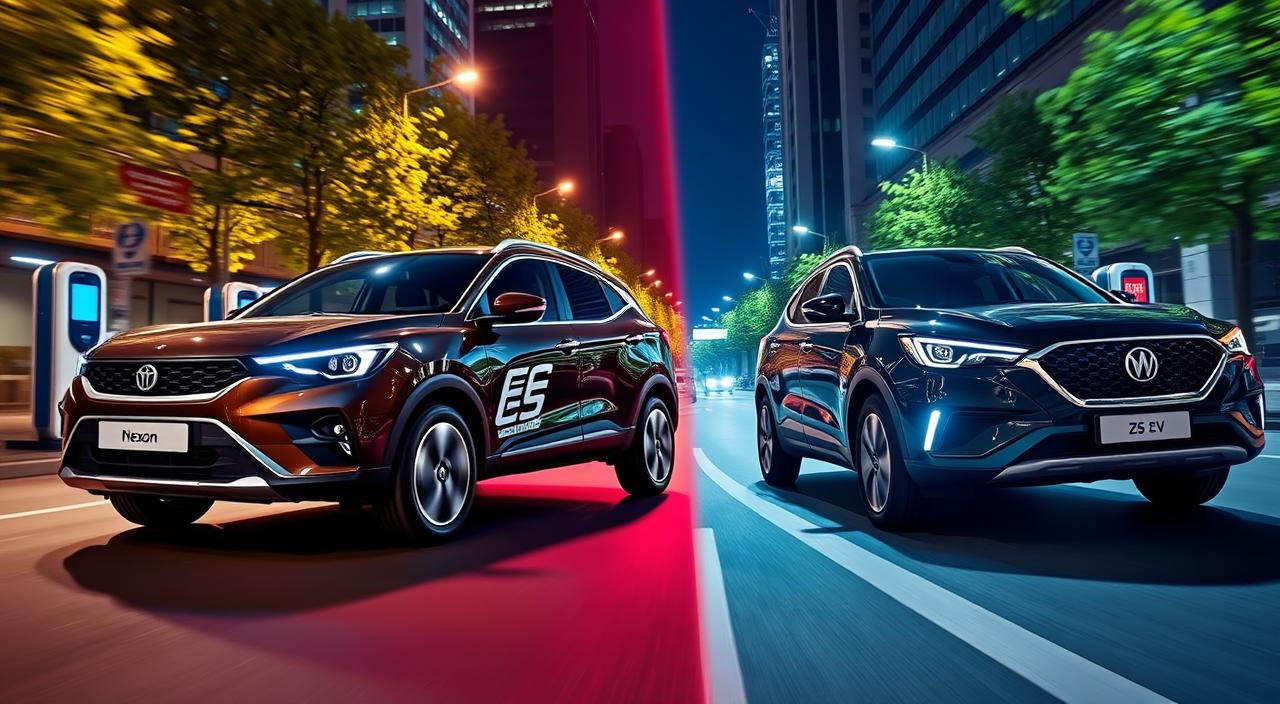
Jan
In India, over 90% of cars use fossil fuels. But electric vehicles (EVs) are quickly becoming popular. The Tata Nexon EV Max and the MG ZS EV are leading the charge. They offer great performance, long ranges, and advanced features. But which one is the best?
I’ve compared these two electric SUVs to find the best value for Indian buyers. I’ve tested them on the road and looked at their specs. The Tata Nexon EV got a big update in 2023, and the MG ZS EV is making waves. This comparison is going to be exciting.
The Tata Nexon EV can go from 10% to 80% in 56 minutes with a 50 kW charger. It has a range of 390 to 489 km. The MG ZS EV has a range of 461 km. Both EVs are very safe, with top safety ratings from Bharat NCAP and Euro NCAP.
Key Takeaways
- Tata Nexon EV Max and MG ZS EV are leading contenders in the Indian electric SUV market
- Tata Nexon EV offers a range of 390 to 489 km per charge, while MG ZS EV delivers 461 km
- Both EVs boast impressive safety ratings, with 5-star ratings from Bharat NCAP and Euro NCAP respectively
- Real-world performance, charging options, and advanced features are key factors in determining the superior EV
- This comparison aims to help Indian buyers choose between these two electric SUVs
Introduction to EVs and Their Importance
Electric vehicles (EVs) are changing the car world. They are cleaner and more efficient than gas cars. EVs help fight climate change and air pollution by using less fossil fuel.
Why Electric Vehicles Matter
EVs are good for the environment. They don’t pollute the air or contribute to climate change. This is key in cities where air quality is a big issue.
EVs also save money in the long run. They might cost more upfront, but they need less maintenance and electricity is cheaper than gas. As technology gets better, EVs will get cheaper, making them a smart choice for many.
The Growth of EV Popularity
More people are choosing EVs, thanks to government help and better charging spots. In India, the government offers tax breaks and subsidies. This makes EVs more affordable for many.
As more people buy EVs, there are more places to charge them. India is adding thousands of charging stations. This makes long trips in EVs easier and worry-free.
| EV Model | Battery Capacity (kWh) | Range (km) |
|---|---|---|
| Tata Nexon EV Max | 40.5 | 437 |
| MG ZS EV | 50.3 | 461 |
| Hyundai Kona Electric | 39.2 | 452 |
| Mahindra XUV400 EV | 39.5 | 456 |
| BYD Atto 3 | 60.5 | 521 |
The table shows some top EVs in India, with their battery sizes and ranges. The BYD Atto 3 has the longest range, great for long trips.
Overview of Tata Nexon EV Max
The Tata Nexon EV Max is a big leap in the Indian electric SUV market. It combines power, features, and design in a unique way. With its strong electric motor and big battery, it offers a thrilling drive and zero emissions.
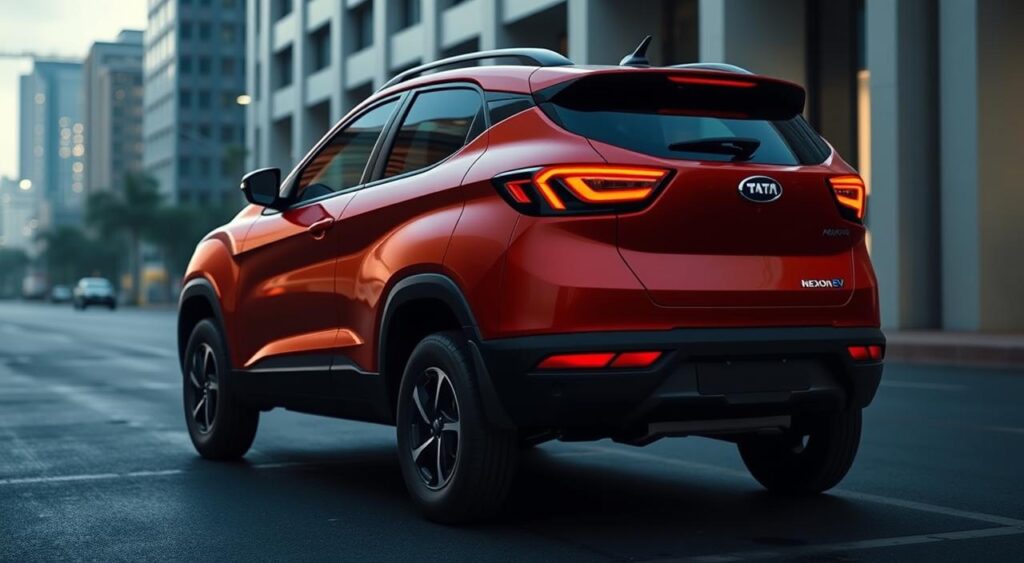
Key Specifications and Features
The Tata Nexon EV Max has a 40.5 kWh battery pack. It can go up to 437 km on a single charge, as certified by ARAI. The electric motor provides quick acceleration and smooth driving. It also comes with:
- 7-inch touchscreen infotainment system
- Automatic climate control
- Connected car technology
- Multiple driving modes
The Nexon EV Max is offered in two battery sizes: 30 kWh and 40.5 kWh. Prices start at Rs 12.49 Lakh and go up to Rs 17.19 Lakh (ex-showroom, New Delhi). It’s great for daily drives and weekend trips, with a real-world range of up to 300 km.
Design and Build Quality
The exterior design of the Tata Nexon EV Max is eye-catching. It has sleek lines and modern looks. The front grille, alloy wheels, and LED headlamps make it look premium. The Tata Avinya, built on JLR’s EMA platform, shows Tata Motors’ dedication to EVs.
Inside the Nexon EV Max, you’ll find a well-made interior. It’s filled with quality materials and has plenty of room for passengers. The seats are designed for comfort, making long drives easy.
| Parameter | Tata Nexon EV Max |
|---|---|
| Price Range | Rs 12.49 – 17.19 Lakh* |
| Range | 390 – 489 km |
| Battery Capacity | 40.5 – 46.08 kWh |
| Charging Time | 56 minutes (10% to 80%, 50kW charger) |
| User Rating | 4.4/5 (based on 168 reviews) |
Overview of MG ZS EV
The MG ZS EV is a sleek and modern electric SUV. It combines performance, comfort, and advanced features. Its striking exterior styling and spacious interior make for a great driving experience. It’s designed for the future of sustainable mobility.
Key Specifications and Features
The MG ZS EV has a 50.3 kWh battery and a claimed range of 461 km (ARAI). It has a powerful electric motor that produces 173 bhp and 280 Nm of torque. This makes for a responsive and dynamic drive.
The ZS EV also has a 5-star safety rating from Euro NCAP. This shows it’s safe and reliable.
| Specification | Value |
|---|---|
| Battery Capacity | 50.3 kWh |
| Claimed Range (ARAI) | 461 km |
| Real-World Range | 330 km (82.5% of claimed) |
| Power Output | 173 bhp |
| Torque | 280 Nm |
| Charging Time | 16 hours |
Design and Interior Comfort
The MG ZS EV’s interior space is well-designed. It offers ample room for passengers and many comfort features. The cabin features a 10.1-inch touchscreen infotainment system for easy connectivity.
The panoramic sunroof adds luxury, letting natural light in. This makes the interior bright and welcoming.
With a seating capacity of 5, the ZS EV is comfortable for everyone. Its dimensions balance interior space and maneuverability. It’s perfect for city drives and weekend trips.
Real-World Performance: Tata Nexon EV Max
The Tata Nexon EV Max is an electric SUV that promises an exciting drive. It has a strong electric motor and a well-tuned suspension. This makes it perform well in real-world driving.
Acceleration and Speed Tests
In acceleration tests, the Tata Nexon EV Max shows off its electric power. It goes from 0 to 100 kmph in just 8.75 seconds. This makes it one of the fastest in its class.
The electric motor’s instant torque gives a thrilling boost. This makes passing and merging onto highways easy.
To compare the Tata Nexon EV Max with its rival, the MG ZS EV, let’s look at their performance:
| Model | 0-100 kmph Time | Top Speed |
|---|---|---|
| Tata Nexon EV Max | 8.75 seconds | 140 kmph |
| MG ZS EV | 8.5 seconds | 140 kmph |
The table shows the Tata Nexon EV Max is close to the MG ZS EV in acceleration. This highlights its strong performance.
Handling and Ride Comfort
The Tata Nexon EV Max handles well, thanks to its well-designed chassis and suspension. It has precise steering and little body roll. This makes it confident on twisty roads or busy city streets.
The low center of gravity from the battery pack adds to its stability and cornering. This makes the Nexon EV Max a joy to drive.
The Nexon EV Max also balances comfort and sportiness well. Its suspension absorbs road bumps, giving a smooth ride. Even on rough roads, the cabin stays calm, ensuring a pleasant drive.
Here’s a comparison of the ride quality between the Tata Nexon EV Max and MG ZS EV:
| Model | Ride Comfort Rating |
|---|---|
| Tata Nexon EV Max | 4/5 |
| MG ZS EV | 3.5/5 |
The Tata Nexon EV Max has a slight edge in ride comfort. It offers a more composed and comfortable ride for passengers.
In summary, the Tata Nexon EV Max impresses with its real-world performance. It has quick acceleration, responsive handling, and a comfortable ride. Its well-rounded performance makes it a great choice for an electric SUV.
Real-World Performance: MG ZS EV
The MG ZS EV stands out in real-world performance. It offers a thrilling drive with fast acceleration, smooth handling, and a comfy ride.
The ZS EV’s quick start is a highlight. In acceleration tests, it hits 0-100 kmph in about 8.5 seconds. This speed comes from its strong electric motor, which produces 177 PS and 280 Nm of torque.
The MG ZS EV also excels in handling. It has precise steering and stable turns, making driving confident. The suspension balances sportiness and comfort, keeping the ZS EV steady on tough roads.
Ride Comfort and Noise Levels
The MG ZS EV is also great for comfort. Its cabin is well-insulated, reducing noise from the road and wind. The seats are plush, supporting you on long trips. The electric powertrain makes the ride smooth and quiet, adding to the comfort.
| Specification | Value |
|---|---|
| Year of Manufacture | 2022 |
| Kilometers Driven | 32,000 km |
| Real-World Range | 330 km |
| Battery Capacity | 50 kWh |
The MG ZS EV has a range of 330 km and a 50 kWh battery. It’s efficient, letting you go far on a single charge. This makes it perfect for daily drives and weekend trips.
Battery Capacity and Range: Tata Nexon EV Max
The Tata Nexon EV Max has a 40.5 kWh battery pack. It offers a great driving range for most electric vehicle owners. With one charge, it can go about 300-350 km. This depends on driving conditions, how you use it, and your driving style.
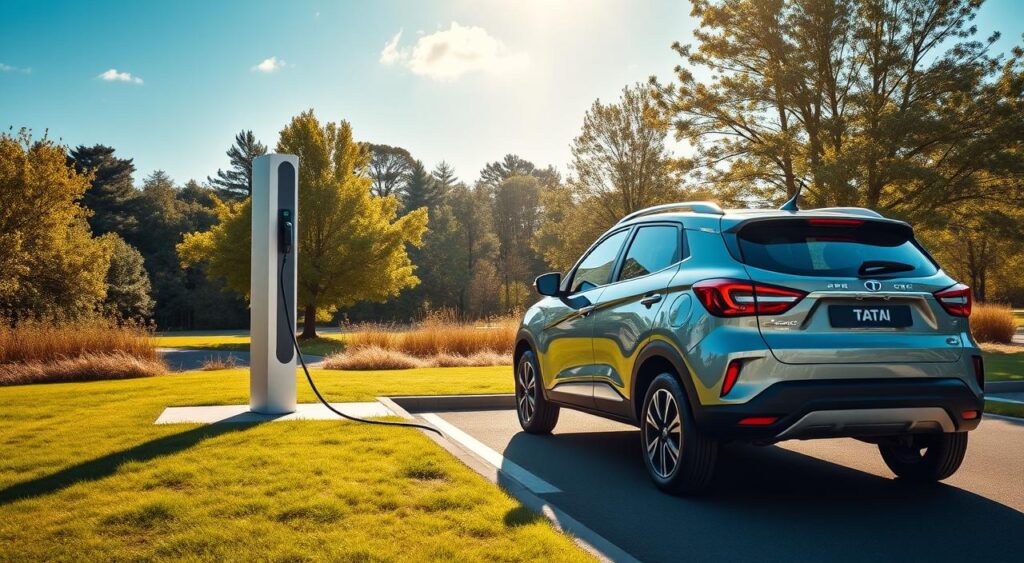
Real-World Driving Range
In real-world tests, the Tata Nexon EV Max has shown its reliability. A test in Mumbai showed it could go 356 km on about 91% of its battery. This makes buyers confident it can handle daily drives and occasional long trips without worry.
Charging Times and Options
The Tata Nexon EV Max has flexible charging options. It supports both regular and fast charging. With a 60 kW DC fast charger, it can go from 0-80% in about 40 minutes. This is faster than the previous LR variant.
| Charging Option | Charging Time |
|---|---|
| 60 kW DC Fast Charging | 0-80% in 40 minutes |
| 3.2 kW AC Charger | 17.5 hours |
| 7.2 kW AC Charger | 6.5 hours |
For home or office charging, the Nexon EV Max supports AC charging. A 3.2 kW AC charger takes about 17.5 hours to fully charge. A 7.2 kW AC charger does it in about 6.5 hours. This means you can start each day with a full battery.
Tata’s growing charging infrastructure in India makes owning a Nexon EV Max more convenient. With more charging stations, like those by BPCL, owners can plan trips knowing they can charge up along the way.
Battery Capacity and Range: MG ZS EV
The MG ZS EV has a big 50.3 kWh battery pack. This is bigger than many electric SUVs. It claims a range of 461 km on a single charge. But, real-world driving can change this, based on how you drive, the terrain, and the weather.
Real-World Driving Range
MG ZS EV owners say they get about 330 km in real life. They’ve driven a total of 32,000 km. This is about 18% less than the claimed range, due to various factors.
The MG ZS EV’s range is good compared to others. For example, the Tata Nexon EV Max has a range of about 360 km with a smaller battery.
Charging Infrastructure and Options
MG is working hard to add more charging spots in India for ZS EV owners. They offer a 7.4 kW AC fast charger. It can fill the battery from 0-100% in about 9 hours. For quicker charging, the ZS EV also supports 50 kW DC fast charging, which can charge to 80% in just 1 hour.
| Charging Option | Charging Time |
|---|---|
| 7.4 kW AC | 9 hours (0-100%) |
| 50 kW DC | 1 hour (0-80%) |
Most MG ZS EV owners charge at home, with 95% of charging done there. Only 5% use fast charging spots. This shows that most owners find the range good for daily use and only need fast charging for longer trips.
Comparing Driving Range in Urban vs. Highway Conditions
Electric vehicles are all about their driving range. The Tata Nexon EV Max and MG ZS EV are top picks in India. They each have their own strengths in city and highway driving.
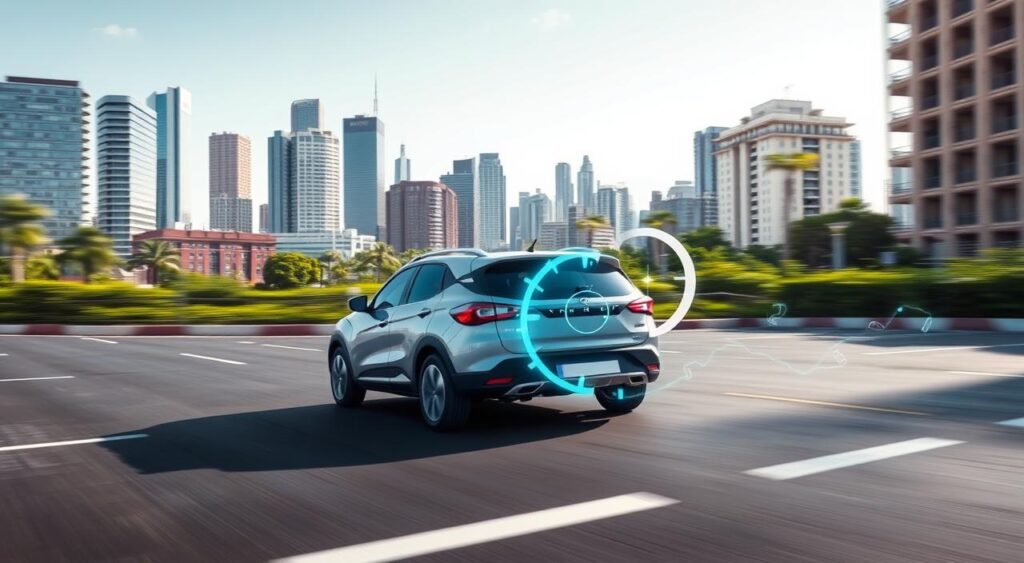
Tata Nexon EV Max in Urban Settings
The Tata Nexon EV Max is great for city driving. It has a powertrain and regenerative braking that save energy. This means it can go about 250-300 km on one charge, perfect for daily city trips.
It also has a regenerative braking system. This system captures energy when you slow down or brake. It’s perfect for city driving where you stop and start a lot.
The Nexon EV Max has a real-world range of 453 km. It has a 40.5 kWh battery and a motor that gives 143 PS of power and 250 Nm of torque. This makes driving smooth and fun.
MG ZS EV in Highway Conditions
The MG ZS EV is a powerhouse on highways. It has a big 50.3 kWh battery. This lets it go about 300-350 km on one charge, great for long trips.
Its motor is strong, with 176 PS of power and 280 Nm of torque. This makes highway driving confident and enjoyable. It can go up to 461 km on a single charge, perfect for long trips.
| EV Model | Urban Driving Range | Highway Driving Range |
|---|---|---|
| Tata Nexon EV Max | 250-300 km | – |
| MG ZS EV | – | 300-350 km |
Both the Tata Nexon EV Max and MG ZS EV have great ranges. The Nexon is best for city driving, while the ZS EV is great for highways. Your choice depends on your driving needs and preferences.
Practicality and Everyday Usability
Electric SUVs are great for daily use. The Tata Nexon EV Max and MG ZS EV have lots of room for cargo. They’re perfect for families or anyone needing a versatile car.
The Tata Nexon EV Max has a big 350-liter boot. It’s great for carrying luggage, groceries, and more. The MG ZS EV has even more space, with 448 liters, so you can store everything you need.
Getting in and out of these SUVs is easy. They have comfortable seats for everyone. The inside is designed for modern families, making driving a pleasure.
Comfort Features
Both SUVs focus on comfort for a smooth ride. They come with:
- Adjustable seats with lumbar support
- Automatic climate control
- Spacious and comfy rear seats
- Plenty of legroom and headroom
Comparing Cargo Space and Practicality
| Electric SUV | Boot Space (Liters) | Seating Capacity | Ground Clearance (mm) |
|---|---|---|---|
| Tata Nexon EV Max | 350 | 5 | 205 |
| MG ZS EV | 448 | 5 | 177 |
The table shows both SUVs have lots of space for cargo and passengers. The Tata Nexon EV Max has a bit more ground clearance. This helps when driving on rough roads.
In summary, the Tata Nexon EV Max and MG ZS EV are top picks for practical electric SUVs. They’re reliable and versatile, making them great for daily use.
Safety Ratings and Features
Both the Tata Nexon EV Max and MG ZS EV are leaders in Electric SUV safety. The Tata Nexon EV Max has a strong safety package. The MG ZS EV has received high marks in safety tests worldwide.
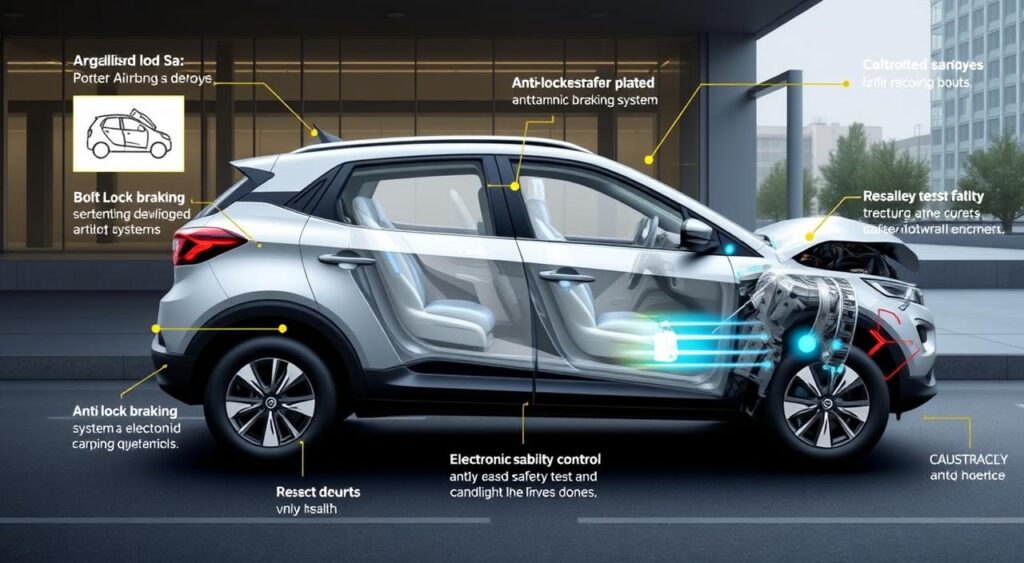
Tata Nexon EV Max Safety Features
The Tata Nexon EV Max focuses on keeping everyone safe. It comes with:
- Disc brakes on all wheels
- Electronic Stability Program (ESP)
- Traction Control
- Tire Pressure Monitoring System (TPMS)
- Electronic parking brake with auto hold
- Six airbags for all-around protection
These advanced driver assistance systems make driving safer and more confident. The Nexon EV Max’s solid build and safety design earn it a 5-star Global NCAP rating. This makes it a top choice for affordable diesel cars in India.
MG ZS EV Safety Ratings
The MG ZS EV also shines in safety tests, earning a 5-star Euro NCAP rating. It offers:
- Six airbags for complete occupant protection
- Hill start assist for smooth starts on hills
- Tire pressure monitoring system for safety and performance
- Adaptive cruise control for easy highway driving
- Lane keep assist to stay in the right lane
Its advanced safety features and strong build make the ZS EV a safe choice. It gives drivers and passengers confidence and peace of mind on every trip.
Owner Experiences: Real-World Feedback
Choosing an electric SUV? Real feedback from owners is key. It shows how these cars perform and work in everyday life. Let’s dive into what Tata Nexon EV Max and MG ZS EV owners say.
Tata Nexon EV Max Owners’ Testimonials
People love the Tata Nexon EV Max. They say it’s great to drive, both in the city and on the highway. Its range of about 360 km meets most daily needs.
One owner has driven 23,000 km. They mostly charge at home, using fast charging just 4 times. This shows how easy it is to charge at home. Another owner, with 25,000 km, says they get 290 km at 100 km/h on the highway. This proves the car’s efficiency.
MG ZS EV Owners’ Testimonials
MG ZS EV owners are happy too. They like the roomy interior and cool features like the panoramic sunroof. The car’s range of about 330 km is enough for most.
An owner with 32,000 km on their ZS EV uses it 50/50 for city and highway driving. They charge at home 95% of the time. They also praise the car’s safety, thanks to its 5-star Euro NCAP rating.
| Model | Average Real-World Range | ARAI / Manufacturer Claimed Range |
|---|---|---|
| MG ZS EV | 330 km | 400 km |
| Tata Nexon EV Max | 360 km | 453 km |
Both the MG ZS EV and Tata Nexon EV Max have great ranges. The Nexon EV Max has a slight edge. But, both are good for daily use. Your choice might depend on what you value most.
Final Verdict: Which EV Reigns Supreme?
After looking at the Tata Nexon EV Max and the MG ZS EV, we see both have good points and areas to improve. The Tata Nexon EV Max is a strong contender with its 143 PS power and 0-100 km/h in 9.14 seconds. It also has a 453 km range and uses 14.6 kWh/100 km, making it a cost-effective choice.
The MG ZS EV, on the other hand, has a 461 km range and a 44.5 kWh battery. It packs 150 PS and accelerates to 100 km/h in 8.5 seconds. Its large interior and 449 liters of boot space make it great for families or those needing more space.
Summary of Key Differences
Comparing the Tata Nexon EV Max and the MG ZS EV, we find some key differences. The Nexon EV Max starts at ₹14.74 lakh, while the ZS EV costs ₹23.38 lakh. The Nexon EV Max is more energy-efficient, using 14.6 kWh/100 km compared to the ZS EV’s 17 kWh/100 km. Yet, the ZS EV has a bigger battery and more room inside, which might sway some buyers.
Recommendations Based on Needs
The choice between the Tata Nexon EV Max and the MG ZS EV depends on what you value most and your budget. If you want a budget-friendly electric SUV with great performance, the Tata Nexon EV Max is a good pick. It’s priced lower and has high customer satisfaction.
But, if you need a longer range, faster speed, and more space, the MG ZS EV might be better, even if it costs more. Both electric SUVs are great options for those looking to go green and join the EV trend.
FAQ
How do the Tata Nexon EV Max and MG ZS EV compare in terms of real-world performance?
Both the Tata Nexon EV Max and MG ZS EV show great speed. The Nexon EV Max goes from 0-100 kmph in 8.75 seconds. The ZS EV does it in about 8.5 seconds. They both handle well and are comfortable to drive, making them great for city and highway use.
What is the real-world driving range of the Tata Nexon EV Max and MG ZS EV?
The Tata Nexon EV Max has a range of 300-350 km on a single charge. It has a 40.5 kWh battery pack. The MG ZS EV, with a 50.3 kWh battery, has a range of 350-400 km. This depends on how you drive and your usage.
How do the charging options and times compare for the Tata Nexon EV Max and MG ZS EV?
The Tata Nexon EV Max can charge fast or regular. A 0-80% fast charge takes 60 minutes with a DC fast charger. The MG ZS EV can charge to 100% in 6-8 hours with a 7.4 kW AC fast charger. Both brands are adding more charging spots in India for EV owners.
Which electric SUV offers more cargo space and practical storage solutions?
Both SUVs have lots of space and smart storage. The Nexon EV Max has a 350-liter boot. The ZS EV has 448 liters of cargo space. They both have comfy interiors and easy access.
How do the Tata Nexon EV Max and MG ZS EV fare in terms of safety features and ratings?
The Tata Nexon EV Max has safety features like dual airbags and ABS. The MG ZS EV got a 5-star safety rating from Euro NCAP. It has six airbags and other safety features.
What are the experiences of Tata Nexon EV Max and MG ZS EV owners in the real world?
Tata Nexon EV Max owners love its performance and comfort. MG ZS EV owners like its space and features. Both groups are happy with their electric cars.
